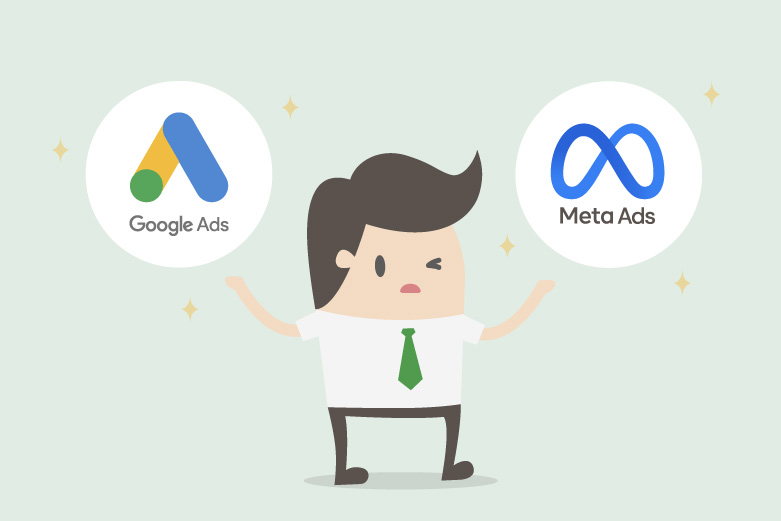
Google Ads vs. Meta Ads: Which Is Best For Your Business?
You’re ready to invest in online advertising, but there’s a big question standing in your way: Should you choose Google Ads vs. Meta Ads?
Both platforms are powerful. Both can drive traffic, leads, and sales. But they work in different ways and serve different goals.
Let’s break down the differences between Google and Meta advertising: how they work, who they work best for, what they cost, and how to get the most bang for your budget.
What Are Google Ads and Meta Ads?
Let’s start with the basics.
Google Ads
Google Ads is Google’s paid advertising platform. It gives businesses access to Google Search, YouTube, Gmail, and the Display Network (millions of partner websites and apps). With Google Ads, your business appears when someone actively looks for something, making it great for capturing high-intent traffic.
You can run:
- Search Ads: Text ads on Google search results pages.
- Display Ads: Banner/image ads across websites and apps.
- Shopping Ads: Product-based ads with images and prices.
- YouTube Ads: Skippable or unskippable video ads.
Google Ads is built on intent. People type in what they want—you show up if it matches your offer.
Meta Ads
Meta Ads run across Facebook, Instagram, Messenger, and the Audience Network. Unlike Google, Meta doesn’t rely on what users are searching for. It taps into who they are—their interests, behaviours, age, gender, job title, life events, and more.
You can create:
- Image and Video Ads
- Carousel Ads
- Stories and Reels
- In-App Messenger Ads
These ads are placed where users scroll and engage. That makes Meta ideal for discovery, brand awareness, and retargeting.
Audience Targeting Capabilities
Both platforms offer powerful targeting tools, but they work in different ways.
Google Ads Targeting
Google’s strength lies in search intent. People come to Google to find something—now. Your ads show based on:
- Keywords they search
- Location and device
- Time of day
- Custom audiences
- Retargeting (based on past site visits)
Google also uses machine learning to improve campaign performance and attract more leads over time. With features like Responsive Search Ads and Performance Max, it helps advertisers reach users across multiple Google channels with minimal manual input.
Meta Ads Targeting
Meta offers deeply layered, behaviour-based targeting. You can build audiences from:
- Interests (fitness, parenting, tech, etc.)
- Demographics (age, gender, education, etc.)
- Behaviours (purchases, app usage, travel)
- Custom Audiences (e.g., people who visited your website)
- Lookalike Audiences (people similar to your best customers)
Meta’s algorithm is especially strong at matching your ads to users who are likely to take action, even if they didn’t show clear intent like a Google search.
Ad Formats and Placements
Each platform offers diverse ad formats to suit different campaign goals.
| Google Ads | Meta Ads |
|---|---|
| Search Ads: Perfect for capturing demand | Photo and Video Ads: The core of Instagram and Facebook |
| Display Ads: Great for remarketing and brand exposure | Carousel Ads: Multiple images or videos in one ad |
| Shopping Ads: Essential for eCommerce brands | Stories/Reels: Full-screen mobile-first experiences |
| YouTube Ads: Powerful for storytelling and awareness | Messenger Ads: Personal and interactive |
Meta’s visual-first experience allows businesses to tell stories and show off products in highly creative, scroll-stopping ways.
Cost & Budgeting
Ad costs can vary widely depending on your industry, goals, and targeting. But here’s a general overview:
| Metric | Google Ads | Meta Ads |
| Average CPC | $1–$5+ | $0.30–$1.50 |
| CPM (Cost per 1,000 views) | $2–$10 | $1–$4 |
| Conversion Rate | 2%–5% | 1.5%–3% |
While Meta often has a lower CPC and CPM, Google Ads may deliver better ROI for purchase-ready audiences. Meta excels when you’re nurturing awareness and engagement over time.
That said, ROI also depends heavily on your creatives, funnel setup, and offer. A poorly optimised Meta campaign can waste your budget. The same goes for a Google Ads campaign targeting irrelevant keywords.
Which Platform Fits Your Business Goals?
Here’s a quick guide based on common marketing goals:
| Business Goal | Best Platform | Why |
| Generate Leads | Google Ads | High intent = better lead quality |
| Build Brand Awareness | Meta Ads | Creative formats + huge reach |
| Drive Website Traffic | Both | Google = intent; Meta = volume |
| Sell Online | Both | Combine Shopping + Social retargeting |
| Launch a New Product | Meta Ads | Visual storytelling drives curiosity |
| Retarget Abandoned Carts | Meta Ads | Custom audiences + dynamic ads |
| Local Service Bookings | Google Ads | Search-driven discovery |
Can You Use Google Ads and Meta Ads Together?
Absolutely, and you should.
Using Google Ads and Meta Ads in tandem creates a full-funnel strategy:
- Use Meta Ads to introduce your brand and educate your audience.
- Use Google Ads to capture searchers when they’re ready to act.
- Retarget users across both platforms to stay top of mind.
The better platform isn’t always the cheaper one. It’s the one that matches your business model, audience behaviour, and marketing goals.
In 2025, digital advertising is more competitive than ever. To stand out, you need to go beyond boosting posts or running one-off campaigns. You need a clear strategy and the right platform mix.
Want help building a custom lead strategy for your business? Dive into our lead generation guide and learn the industry secrets that convert.


